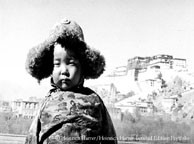Newly Donated "Seven Years in Tibet" Photos to be Displayed at Reception
NEW YORK, April 14, 2005 Columbia’s C. V. Starr East Asian Library and the Modern Tibetan Studies Program are hosting a reception on Friday, April 15, 2005, in the Kress Rare Book and Special Collections Reading Room in Kent Hall at 5:30 P.M. The reception will feature a portfolio of ten silver gelatin photographs taken by the world-renowned explorer Heinrich Harrer from his critically acclaimed exhibition, “Seven Years in Tibet, 1944–1951, Photographs by Heinrich Harrer.”

The reception will also honor the distinguished scholar and Tibetologist Gene Smith, one of the leading figures in Tibetan studies, for his moral, intellectual, and practical support to Columbia's Modern Tibetan Studies Program. The program, the first of its kind in the West, is also honoring the dedication and commitment of Carol Rattray and Elise Frick, who have been among those who have supported the Program since it was started six years ago.
The "Seven Years in Tibet" portfolio is being donated to the C. V. Starr East Asian Library by Katie Grover and Mike Campbell. It is the first limited-edition portfolio ever produced from noted explorer Heinrich Harrer's unique treasury of 3,000 images of traditional Tibet shot between 1948 and 1951. The portfolio comprises ten images representing a poignant visual essay of traditional Tibet.
Leslie DiRusso, Publisher of the Heinrich Harrer Limited Edition Portfolio, will introduce the portfolio and give a brief presentation.
“We are deeply grateful that our library has been chosen to receive this world-renowned portfolio,” noted Amy Heinrich, Director of the C. V. Starr East Asian Library. “Together with the books and materials donated by Carol Rattray, Elise Frick and others, and the research materials produced by Gene Smith, it will certainly add to the depth and richness of our collection.”
Heinrich Harrer, then an Austrian mountaineer, escaped over the Himalayas from a prisoner-of-war camp in British India, and lived and worked as a fifth-ranked official in the Tibetan capital, Lhasa. As an informal tutor to the young Tibetan leader, the Dalai Lama, Harrer was afforded access to ceremonies and customs that had been rarely witnessed by Westerners, many of which he photographed. He left Lhasa in advance of the Chinese army in December 1950. Harrer’s memoir, “Seven Years in Tibet,” has been translated into 53 languages and was adapted as a major motion picture in 1997.
Gene Smith, author of Among Tibetan Texts: History and Literature of the Himalayan Plateau, was the field director of the Library of Congress Field Office in India, Indonesia, and Cairo. Smith later helped establish the Himalayan and Inner Asian Resources library in New York (now the Latse Library) and then set up the Tibetan Buddhist Resource Center, which is now part of the Rubin Museum of Art on West 17th St, Manhattan, established by Shelley and Donald Rubin. Carol Rattray is known for her work through the Rattray Kimura Foundation on environmental preservation in Yunnan and other areas of southwest China, and has worked with the Tibet Heritage Fund on architectural conservation in Tibetan areas. Elise Frick is a long-term student of modern Tibetan language and studies, and has been a generous supporter of Columbia's Tibetan Studies initiative since its inception. Katie Grover, currently Chair of the Board of the Ms. Foundation for Women, and Mike Campbell, CEO of Dominick and Dominick, are known in particular for their humanitarian work with Tibetan children through the Wellspring Foundation.
For additional information about the reception, please call 212-854-3076 or e-mail ds2397@columbia.edu.
Columbia’s Modern Tibetan Studies Program is the first program dedicated to teaching about the society, history, culture and economics of modern Tibet. Linked to multiple Tibet-studies initiatives in the US and Europe, it also supports and carries out research into modern Tibet, runs a study program at Tibet University in Lhasa, and organizes a program of public activities in New York. In Spring 2004, Columbia established the world's first chair in modern Tibetan studies, with a $3 million gift from the Henry Luce Foundation. The new chair builds on the Columbia initiatives on Tibet led by Professor Madeleine Zelin and Dr. Robert Barnett of Columbia's Weatherhead East Asian Institute since 1999. The university now offers instruction in both modern and classical Tibetan language, courses that cover topics ranging from Tibetan religion to contemporary Tibetan culture, art and history, and a major Tibetan library collection.
The C.V. Starr East Asian Library is one of the major collections for the study of East Asia in the United States, with over 760,000 volumes of Chinese, Japanese, Korean, Tibetan, and Western language materials, as well as some holdings in Mongol and Manchu, and over 6,000 periodical titles. The collection, established in 1902, is particularly strong in Chinese history, literature, and social sciences; Japanese literature, history, and religion, particularly Buddhism; and Korean history. The Library’s website is located at http://www.columbia.edu/cu/lweb/indiv/eastasian/.
Columbia University Libraries is one of the top ten academic library systems in the nation, with 9.2 million volumes, over 65,650 serials, as well as extensive collections of electronic resources, manuscripts, rare books, microforms, and other nonprint formats. The collections and services are organized into 25 libraries, supporting specific academic or professional disciplines. Columbia Libraries employs more than 400 professional and support staff to assist faculty, students, and researchers in their academic endeavors. The Libraries’ website at http://www.columbia.edu/cu/lweb/ is a gateway to its print and electronic collections and to its services.
-END-
04/14/05 JD